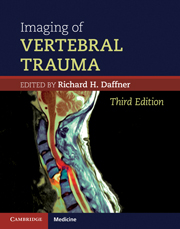Book contents
- Frontmatter
- Contents
- List of contributors
- Preface to the Third Edition
- Preface to the Second Edition
- Preface to the First Edition
- Acknowledgments
- 1 Overview of vertebral injuries
- 2 Anatomic considerations
- 3 Biomechanical considerations
- 4 Imaging of vertebral trauma I: indications and controversies
- 5 Imaging of vertebral trauma II: radiography, computed tomography, and myelography
- 6 Imaging of vertebral trauma III: magnetic resonance imaging
- 7 Mechanisms of injury and their “fingerprints”
- 8 Radiologic “footprints” of vertebral injury: the ABCS
- 9 Vertebral injuries in children
- 10 Vertebral stability and instability
- 11 Normal variants and pseudofractures
- Index
Preface to the Third Edition
Published online by Cambridge University Press: 21 April 2011
- Frontmatter
- Contents
- List of contributors
- Preface to the Third Edition
- Preface to the Second Edition
- Preface to the First Edition
- Acknowledgments
- 1 Overview of vertebral injuries
- 2 Anatomic considerations
- 3 Biomechanical considerations
- 4 Imaging of vertebral trauma I: indications and controversies
- 5 Imaging of vertebral trauma II: radiography, computed tomography, and myelography
- 6 Imaging of vertebral trauma III: magnetic resonance imaging
- 7 Mechanisms of injury and their “fingerprints”
- 8 Radiologic “footprints” of vertebral injury: the ABCS
- 9 Vertebral injuries in children
- 10 Vertebral stability and instability
- 11 Normal variants and pseudofractures
- Index
Summary
The imaging methods used to evaluate patients with suspected vertebral injuries have undergone radical changes since the publication of the second edition of Imaging of Vertebral Trauma in 1996. The most significant of these changes has been the ascendency of computed tomography (CT) to become the primary tool for studying these patients. Radiography now assumes a secondary role, serving mainly for follow-up of known injuries or as a tool to solve problems with CT studies, such as motion or metallic artifacts. Furthermore, there has been an ongoing dialog in the radiologic and trauma literature regarding the indications for imaging in trauma patients, as well as the methods of choice. Of most recent note are the issues of high-radiation dose associated with CT studies as well as the continuing debates on health care reform and cost containment.
The first edition dealt mainly with radiography supplemented with polydirectional or computed tomography and magnetic resonance (MR) imaging. The second edition expanded the discussion of the roles of MR in vertebral injuries. This new edition presents an in-depth discussion on the indications and methods of imaging the spine based on the evidence available in the current literature. Each chapter has been revised with those precepts in mind and the majority of the illustrations have been changed to represent state-of-the-art imaging.
- Type
- Chapter
- Information
- Imaging of Vertebral Trauma , pp. xi - xiiPublisher: Cambridge University PressPrint publication year: 2011



